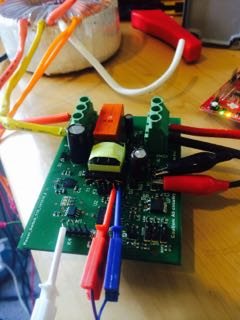Meantime, we've progressed from using the CC3200 Launchpad to developing our own boards and writing some code... And hurrah, this week week we made some progress.. We have designed a board, that measures Power consumption data, and controls a relay to switch a load on/off. Data is sent to/from the board via MQTT. Its functioning reasonably well, as a prototype. ( NB, this has its own AC/DC power supply on board, thats what the transformer is for ). In the picture its hooked up to low voltage ( 12VAC ) via that big transformer and a DC power supply so we can safely probe it, and work with it. The moment it gets on the AC, we can't work on it, nearly as easily.. ( safety! )
I have a few issues that are nagging me;
(1) The RF output and receive on this device ( and in fact the CC3200 Launch pad ) is quite low, so its effective range is quite short. I'm guessing that one of the issues is that the Onboard Antenna has a relatively low gain.. - What options do we have to improve the RF characteristics of this device? Maybe we can attach a bigger ( high gain ) antenna somehow? ( i'm getting very similar results for both our board, and the launchpad )
(2) Code Security - How do you secure your Code when you're using the CC3200. At the moment it seems that you can't? From what i've read it seems there is no way to secure the mcuimg.bin file. We can secure things like Certificates, but protecting our IP is really important as well.
(3) Mass programming. - How would you go about programming 100's if not 1000's of these devices, The idea of connecting a Jtag and programming them one by one with Uniflash scares me, because it would take so long.
I've got a lot to learn about this stuff, so if anyone has some helpful comments, i'd be very appreicative.


